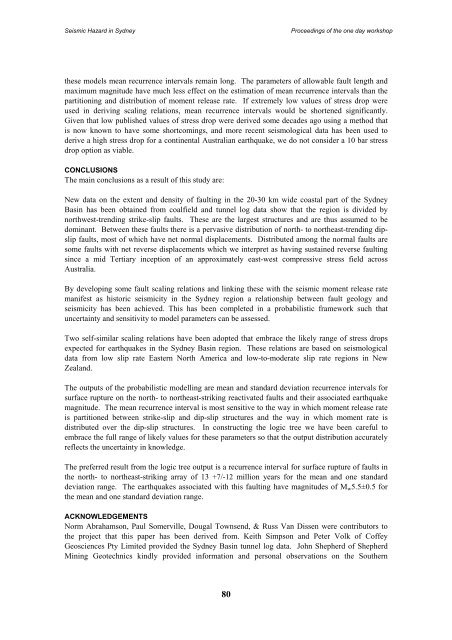Landslides in the Sydney Basin - Geoscience Australia
Landslides in the Sydney Basin - Geoscience Australia
Landslides in the Sydney Basin - Geoscience Australia
- No tags were found...
Create successful ePaper yourself
Turn your PDF publications into a flip-book with our unique Google optimized e-Paper software.
Seismic Hazard <strong>in</strong> <strong>Sydney</strong>Proceed<strong>in</strong>gs of <strong>the</strong> one day workshop<strong>the</strong>se models mean recurrence <strong>in</strong>tervals rema<strong>in</strong> long. The parameters of allowable fault length andmaximum magnitude have much less effect on <strong>the</strong> estimation of mean recurrence <strong>in</strong>tervals than <strong>the</strong>partition<strong>in</strong>g and distribution of moment release rate. If extremely low values of stress drop wereused <strong>in</strong> deriv<strong>in</strong>g scal<strong>in</strong>g relations, mean recurrence <strong>in</strong>tervals would be shortened significantly.Given that low published values of stress drop were derived some decades ago us<strong>in</strong>g a method thatis now known to have some shortcom<strong>in</strong>gs, and more recent seismological data has been used toderive a high stress drop for a cont<strong>in</strong>ental <strong>Australia</strong>n earthquake, we do not consider a 10 bar stressdrop option as viable.CONCLUSIONSThe ma<strong>in</strong> conclusions as a result of this study are:New data on <strong>the</strong> extent and density of fault<strong>in</strong>g <strong>in</strong> <strong>the</strong> 20-30 km wide coastal part of <strong>the</strong> <strong>Sydney</strong>Bas<strong>in</strong> has been obta<strong>in</strong>ed from coalfield and tunnel log data show that <strong>the</strong> region is divided bynorthwest-trend<strong>in</strong>g strike-slip faults. These are <strong>the</strong> largest structures and are thus assumed to bedom<strong>in</strong>ant. Between <strong>the</strong>se faults <strong>the</strong>re is a pervasive distribution of north- to nor<strong>the</strong>ast-trend<strong>in</strong>g dipslipfaults, most of which have net normal displacements. Distributed among <strong>the</strong> normal faults aresome faults with net reverse displacements which we <strong>in</strong>terpret as hav<strong>in</strong>g susta<strong>in</strong>ed reverse fault<strong>in</strong>gs<strong>in</strong>ce a mid Tertiary <strong>in</strong>ception of an approximately east-west compressive stress field across<strong>Australia</strong>.By develop<strong>in</strong>g some fault scal<strong>in</strong>g relations and l<strong>in</strong>k<strong>in</strong>g <strong>the</strong>se with <strong>the</strong> seismic moment release ratemanifest as historic seismicity <strong>in</strong> <strong>the</strong> <strong>Sydney</strong> region a relationship between fault geology andseismicity has been achieved. This has been completed <strong>in</strong> a probabilistic framework such thatuncerta<strong>in</strong>ty and sensitivity to model parameters can be assessed.Two self-similar scal<strong>in</strong>g relations have been adopted that embrace <strong>the</strong> likely range of stress dropsexpected for earthquakes <strong>in</strong> <strong>the</strong> <strong>Sydney</strong> Bas<strong>in</strong> region. These relations are based on seismologicaldata from low slip rate Eastern North America and low-to-moderate slip rate regions <strong>in</strong> NewZealand.The outputs of <strong>the</strong> probabilistic modell<strong>in</strong>g are mean and standard deviation recurrence <strong>in</strong>tervals forsurface rupture on <strong>the</strong> north- to nor<strong>the</strong>ast-strik<strong>in</strong>g reactivated faults and <strong>the</strong>ir associated earthquakemagnitude. The mean recurrence <strong>in</strong>terval is most sensitive to <strong>the</strong> way <strong>in</strong> which moment release rateis partitioned between strike-slip and dip-slip structures and <strong>the</strong> way <strong>in</strong> which moment rate isdistributed over <strong>the</strong> dip-slip structures. In construct<strong>in</strong>g <strong>the</strong> logic tree we have been careful toembrace <strong>the</strong> full range of likely values for <strong>the</strong>se parameters so that <strong>the</strong> output distribution accuratelyreflects <strong>the</strong> uncerta<strong>in</strong>ty <strong>in</strong> knowledge.The preferred result from <strong>the</strong> logic tree output is a recurrence <strong>in</strong>terval for surface rupture of faults <strong>in</strong><strong>the</strong> north- to nor<strong>the</strong>ast-strik<strong>in</strong>g array of 13 +7/-12 million years for <strong>the</strong> mean and one standarddeviation range. The earthquakes associated with this fault<strong>in</strong>g have magnitudes of M w 5.5±0.5 for<strong>the</strong> mean and one standard deviation range.ACKNOWLEDGEMENTSNorm Abrahamson, Paul Somerville, Dougal Townsend, & Russ Van Dissen were contributors to<strong>the</strong> project that this paper has been derived from. Keith Simpson and Peter Volk of Coffey<strong>Geoscience</strong>s Pty Limited provided <strong>the</strong> <strong>Sydney</strong> Bas<strong>in</strong> tunnel log data. John Shepherd of ShepherdM<strong>in</strong><strong>in</strong>g Geotechnics k<strong>in</strong>dly provided <strong>in</strong>formation and personal observations on <strong>the</strong> Sou<strong>the</strong>rn80
















